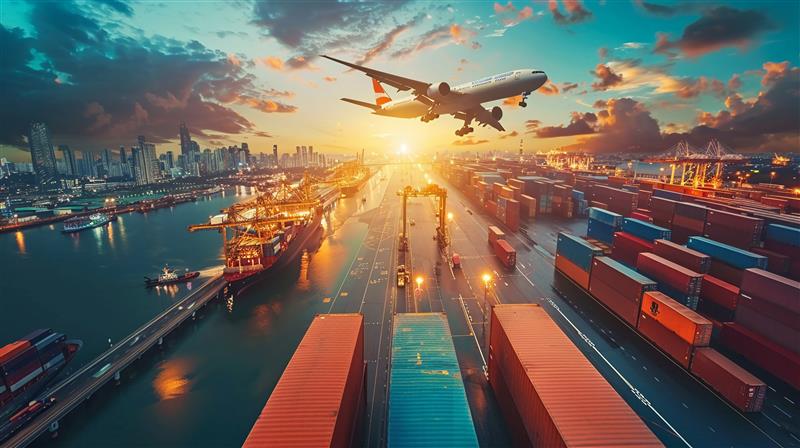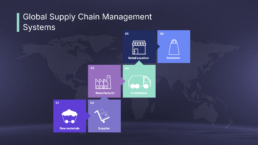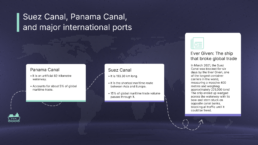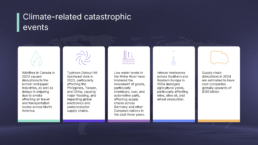Ever wondered how your online purchase could reach your doorstep within days? That’s the power of a well-connected global supply chain that forms the backbone of international trade. It connects manufacturers and consumers while driving efficiency through technological advancements and just-in-time production. However, this intricate network is increasingly confronted with a myriad of challenges. This article explores the current challenges facing the global supply chain and outlines potential pathways for enhancing its robustness in an ever-changing landscape.
What is the global supply chain?
A global supply chain is the network of businesses, resources, people, and processes involved in producing and delivering goods and services across different countries.
- Moving raw materials and converting them into finished products
- Transporting the products to distribution sites
- Distributing the products to customers
- Coordinating the work of suppliers, manufacturers, vendors, warehouses, transportation partners, wholesalers, and retailers
- Managing the logistics of product development, marketing, finance, customer service, business operations, and distribution
Critical chokepoints in the global supply chain
The modern global supply chain is the backbone of international trade, connecting businesses, manufacturers, and consumers worldwide. But we live in an era of constant disruption, rapid digitization and growing consumer demands, which makes global supply chains a complex ever-evolving vortex. Supply chain disruption is now the norm. Congestion of transportation and logistics infrastructure, geopolitical shifts, natural disasters and extreme weather, raw material shortages, are just a few of the factors that affect the global supply chain. As global supply chains span continents, they often pass through critical chokepoints that can become bottlenecks, creating vulnerabilities and highlighting the need for robust contingency planning. Here’s a closer look at the challenges faced by the global supply chain and the strategies companies are adopting to mitigate potential disruptions in it.
Major international ports, which act as hubs for global shipping, face several challenges, from labor strikes and infrastructure limitations to congestion.
Suez Canal, Panama Canal, and major international ports
The Suez and Panama Canals significantly reduce transit times for ships. With over 80% of global trade relying on maritime routes, these canals serve as the lifelines of the supply chain, making their efficiency and stability essential. Any disruptions in these routes disrupt global trade, delaying shipments and causing backlogs at ports.
Disruptions in a post-pandemic world
The prolonged lockdowns, labor shortages, and factory closures during the COVID-19 pandemic highlighted several vulnerabilities in the global supply chain. Additionally, there were demand fluctuations, production delays, rising freight costs, inventory shortages, and transportation limitations that caused further disruptions. Companies were forced to rethink their supply chain strategies, emphasizing the need for more resilient and flexible operations to mitigate such risks in the future.
Labor shortage
Global supply chains often face labor shortages, but addressing these issues requires a focus on ethical labor practices. Ensuring fair wages, safe working conditions, and preventing exploitation are critical. Companies must adopt transparent policies, adhere to labor laws, and collaborate with stakeholders to promote sustainability and human rights in their supply chains.
Truck driver shortage in 2023
In 2023, a report by the International Road Transport Union (IRU) found that truck driver shortages had increased globally. There were over 3 million unfilled truck driver positions in 36 countries, or 7% of total positions. The truck driver shortage is a significant bottleneck in the global supply chain, particularly in the US and Europe, caused by factors such as aging driver populations, stricter regulations, and low recruitment rates. The IRU predicts that the shortage will double by 2028.
Geopolitical jitters
Geopolitical conflicts are among the biggest threats to the global supply chain. Escalating tensions can disrupt the availability of everyday products, affecting everything from essential goods to advanced electronics.
- The Russia-Ukraine conflict has severely disrupted global markets for oil, gas, and wheat, exacerbating inflation, triggering sanctions, and cutting off vital trade routes.
- The Strait of Hormuz—a crucial passageway for oil exports from nations like Saudi Arabia, Iraq, the UAE, and Kuwait—remains a focal point of tension. Conflicts in this area, often involving Iran and other Gulf states in opposition to the US, place the global oil supply at risk, fueling volatility in energy markets.
- Geopolitical tensions in Taiwan, responsible for producing the majority of world’s advanced microchips, pose risks to the semiconductor industry, affecting global production of electronics and automotive components.
Rising protectionism
It’s no secret that the ongoing tension between two of the world’s biggest superpowers, the US and China, has significantly impacted global trade. A key consequence has been the increasingly protectionist stance adopted by the US since 2018, marked by higher tariffs, revisions to or withdrawals from free-trade agreements, and trade restrictions with countries deemed strategic threats.
Several other nations are also moving toward similar policies, reshaping trade agreements and pressuring companies to localize production and reassess global supply networks. These trade conflicts, along with rising tariffs, have compelled businesses to diversify suppliers and shift production to mitigate risks, often driving up costs and adding complexity.
Trade Turbulence
Trade policies essentially strike the global supply chain networks, not only changing product flows but also disrupting supply chains. In a hyper-globalized world, shifting trade regulations across countries are creating more challenges for global businesses, as they must navigate new rules, tariffs, and compliance measures, disrupting established supply chains. An example of this is Brexit in December 2020, which introduced new regulatory barriers, customs checks, and increased border delays as the UK departed from the European Union (EU). As a result, between 2021 and 2023, UK exports to the EU fell by 27% and imports fell by 32%, a report by Aston University Business School has found.
Sanctions and embargoes are powerful tools used by countries and international bodies to influence the behavior of nations and organizations by restricting their economic activities. For instance, in response to Russia’s actions in Ukraine, several countries and international organizations have imposed sanctions targeting key sectors of the Russian economy, including finance, energy, and defense. These sanctions have disrupted trade and investment flows, affecting both Russian and global markets. Likewise, there are several international sanctions imposed by Western countries on nations like Iran, North Korea, and Venezuela, disrupting global trade flows and limiting access to markets and resources.
The Geopolitical Storm
Today’s supply chains face unprecedented political pressures in what McKinsey & Company calls a “fragmenting global order.” Three major disruptions illustrate this reality:
- Russia-Ukraine Conflict:
The transformation of Black Sea ports from vital trade hubs to conflict zones has upended global food supply chains. - U.S.-China Tensions:
Escalating technology restrictions and tariffs have forced companies to restructure their entire supply networks. - Middle East Instability:
Recent Red Sea disruptions have compelled shipping companies to choose between risk and costly detours.
Emerging threats in 2025
A new wave of challenges is materializing for global supply chains. The rise of digital operations has increased the risk of cyberattacks and software issues, while disruptions caused by extreme weather events too are becoming increasingly frequent.
Cyberattacks
Cyberattacks occur when malicious actors exploit vulnerabilities in software, networks, or systems to gain unauthorized access, disrupt services, or steal sensitive information. These attacks can take various forms, such as phishing, malware, ransomware, and denial-of-service (DoS) attacks.
- The SolarWinds attack: Targeted several government agencies and corporations in the United States in 2020.
- Kaseya VSA: This Remote Monitoring and Management (RMM) platform used by managed services providers (MSPs) suffered one of the largest ransomware attacks in history.
Stay vigilant: These incidents demonstrate how sophisticated cyber attackers can infiltrate widely used software, compromising supply chains and affecting thousands of businesses globally. Staying vigilant by regularly updating software, implementing firewalls, and using encryption to protect sensitive data is more crucial than ever. Regular security audits and implementation of zero-trust architecture are needed to stop such attacks. Even at an individual level, employing strong, unique passwords, multi-factor authentication (MFA), and conducting employee cybersecurity training are essential steps in enhancing overall security.
Climate-related catastrophic events
Natural disasters and extreme weather events, such as hurricanes, typhoons, and wildfires, are becoming more frequent and intense, damaging critical infrastructure, disrupting transportation, and delaying production. Disruption due to climate-related catastrophic events could lead to $25 trillion net losses by mid-century, according to a study by Nature. Here are a few climate-related catastrophic events that disrupted global supply chains in 2023 and 2024:
How to build a more resilient supply chain
The key to resilience lies in developing an agile and global supply chain model capable of responding swiftly to changes. Agility allows companies to pivot and adapt in the face of unexpected challenges, while a global supply chain network provides access to a wider range of resources and markets.
Diversification of Suppliers
Businesses can reduce their dependence on a single source by sourcing materials or products from multiple suppliers across different regions. Supplier diversification has the potential to mitigate risks related to geopolitical tensions, natural disasters, or other localized disruptions. For example, when the U.S.-China trade war intensified, many companies began diversifying their supply bases to other parts of Asia, such as Vietnam and India, to reduce reliance on China.
Nearshoring
Nearshoring, or relocating production closer to home markets, enhances supply chain agility by shortening lead times, reducing transportation costs, and improving oversight. It also allows for faster adjustments to meet market demands. This technique enabled businesses to reduce their response times, especially during the pandemic.
Adopting new technologies
Leveraging advanced technologies enables companies to forecast and anticipate demand fluctuations and potential disruptions and take proactive measures to tackle potential supply chain bottlenecks before they occur.
- Predictive analytics for demand forecasting: Advanced algorithms and machine learning models help businesses analyze historical data and market trends to accurately predict demand. This enables proactive inventory management.
- Internet of Things (IoT) for real-time visibility: IoT sensors attached to shipments provide real-time tracking of goods in transit.
- Big Data and data analytics: Comprehensive data analysis empowers organizations to identify inefficiencies, forecast demand, and make informed strategic decisions. Analyzing patterns in supplier performance, transportation routes, and customer behavior enhances overall supply chain efficiency.
- Blockchain: Blockchain technology ensures tamper-proof and transparent records of transactions, enabling trust among stakeholders.
- Automation and robotics: Automated warehouses, robotic picking systems, and autonomous vehicles improve operational efficiency, reduce human error, and optimize labor costs.
- Artificial Intelligence (AI) in supply chain planning: AI-driven tools analyze complex data sets, enabling better supplier selection, route optimization, and demand-supply alignment.
- Cloud Computing for collaboration: Cloud-based platforms facilitate seamless communication among global supply chain stakeholders, ensuring quick data sharing and enhanced collaboration across time zones.
Emerging Trends: The supply chain of the future
The future of supply chain management will be shaped by a combination of sustainability, transparency, and innovation. Like everything else in the world, supply chains too must evolve to preserve the future of our planet, reducing their environmental impact and embracing ethical practices. By integrating cutting-edge technologies and eco-friendly models, businesses can ensure they not only meet consumer expectations but also contribute to a more resilient and responsible global economy.
-
Green supply chain and circular economy models: Adopting green supply chain models that prioritize sustainability.
- Taking the circular economy approach, which focuses on recycling, reuse, and minimizing waste.
- Focusing on reducing carbon footprints through eco-friendly logistics, sustainable packaging, and renewable energy adoption.
-
Blockchain for transparency and traceability: Using blockchain technology to enhance transparency and traceability in supply chains by providing a secure and immutable ledger of transactions.
- This is particularly relevant for industries like food, pharmaceuticals, and luxury goods, for ensuring product authenticity and compliance with regulatory standards.
-
AI in supply chain management: Automating processes, optimizing routes, and enhancing demand forecasting through AI to predict supply chain disruptions, optimize procurement, and improve decision-making.
- Particularly useful in reducing human error and accelerating supply chain operations.
- Shift to regionalization: Moving from globalized supply chains to regional models to reduce dependencies and increase control over operations.
- Ethical sourcing and transparency: Putting greater emphasis on fair labor practices, compliance with regulations, and transparent reporting in procurement processes.
A transformative approach
The evolving landscape of globalization and digitization demands a transformative approach to supply chain management. Businesses must leverage technology for real-time visibility, adopt data-driven decision-making, and build collaborative partnerships to remain competitive. Agility and foresight have proven indispensable in navigating post-pandemic challenges, enabling businesses to withstand disruptions and maintain operational continuity. Resilient supply chains not only safeguard market positions and optimize costs but also foster trust by consistently delivering value to consumers.
Looking ahead, the future of global supply chains will be shaped by several key factors:
Governments will play a pivotal role through policies that encourage trade, infrastructure investments, and environmental regulations, ensuring equitable and sustainable growth.
Developing countries can take advantage of the global supply chains which offers opportunities for economic advancement and job creation.
Consumers, too, wield significant influence through their choices, driving companies to adopt sustainable, transparent, and ethical practices. As businesses strive to balance efficiency, resilience, and sustainability, they must focus on creating supply chains that not only meet present needs but also contribute to a sustainable and equitable future for all.



